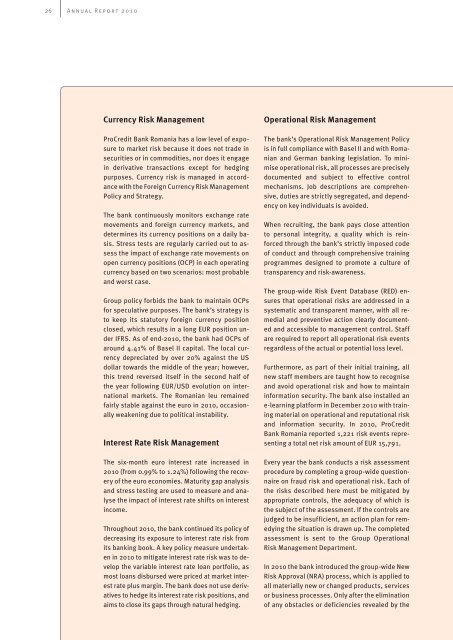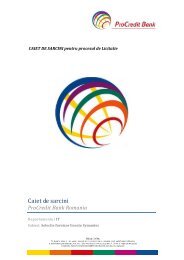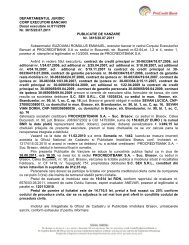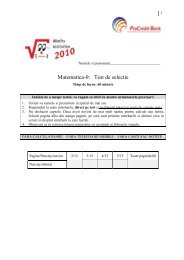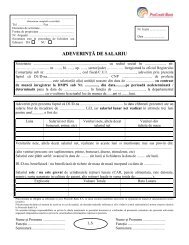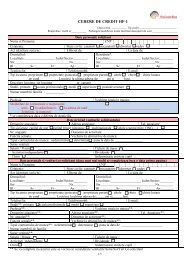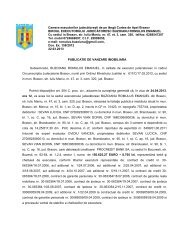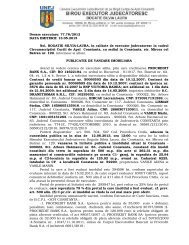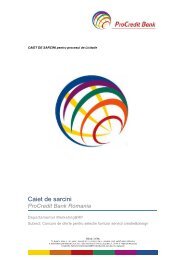Annual Report 2010 - ProCredit Bank
Annual Report 2010 - ProCredit Bank
Annual Report 2010 - ProCredit Bank
Create successful ePaper yourself
Turn your PDF publications into a flip-book with our unique Google optimized e-Paper software.
26<br />
<strong>Annual</strong> <strong>Report</strong> <strong>2010</strong><br />
Currency Risk Management<br />
<strong>ProCredit</strong> <strong>Bank</strong> Romania has a low level of exposure<br />
to market risk because it does not trade in<br />
securities or in commodities, nor does it engage<br />
in derivative transactions except for hedging<br />
purposes. Currency risk is managed in accordance<br />
with the Foreign Currency Risk Management<br />
Policy and Strategy.<br />
The bank continuously monitors exchange rate<br />
movements and foreign currency markets, and<br />
determines its currency positions on a daily basis.<br />
Stress tests are regularly carried out to assess<br />
the impact of exchange rate movements on<br />
open currency positions (OCP) in each operating<br />
currency based on two scenarios: most probable<br />
and worst case.<br />
Group policy forbids the bank to maintain OCPs<br />
for speculative purposes. The bank’s strategy is<br />
to keep its statutory foreign currency position<br />
closed, which results in a long EUR position under<br />
IFRS. As of end-<strong>2010</strong>, the bank had OCPs of<br />
around 4.41% of Basel II capital. The local currency<br />
depreciated by over 20% against the US<br />
dollar towards the middle of the year; however,<br />
this trend reversed itself in the second half of<br />
the year following EUR/USD evolution on international<br />
markets. The Romanian leu remained<br />
fairly stable against the euro in <strong>2010</strong>, occasionally<br />
weakening due to political instability.<br />
Interest Rate Risk Management<br />
The six-month euro interest rate increased in<br />
<strong>2010</strong> (from 0.99% to 1.24%) following the recovery<br />
of the euro economies. Maturity gap analysis<br />
and stress testing are used to measure and analyse<br />
the impact of interest rate shifts on interest<br />
income.<br />
Throughout <strong>2010</strong>, the bank continued its policy of<br />
decreasing its exposure to interest rate risk from<br />
its banking book. A key policy measure undertaken<br />
in <strong>2010</strong> to mitigate interest rate risk was to develop<br />
the variable interest rate loan portfolio, as<br />
most loans disbursed were priced at market interest<br />
rate plus margin. The bank does not use derivatives<br />
to hedge its interest rate risk positions, and<br />
aims to close its gaps through natural hedging.<br />
Operational Risk Management<br />
The bank’s Operational Risk Management Policy<br />
is in full compliance with Basel II and with Romanian<br />
and German banking legislation. To minimise<br />
operational risk, all processes are precisely<br />
documented and subject to effective control<br />
mechanisms. Job descriptions are comprehensive,<br />
duties are strictly segregated, and dependency<br />
on key individuals is avoided.<br />
When recruiting, the bank pays close attention<br />
to personal integrity, a quality which is reinforced<br />
through the bank’s strictly imposed code<br />
of conduct and through comprehensive training<br />
programmes designed to promote a culture of<br />
transparency and risk-awareness.<br />
The group-wide Risk Event Database (RED) ensures<br />
that operational risks are addressed in a<br />
systematic and transparent manner, with all remedial<br />
and preventive action clearly documented<br />
and accessible to management control. Staff<br />
are required to report all operational risk events<br />
regardless of the actual or potential loss level.<br />
Furthermore, as part of their initial training, all<br />
new staff members are taught how to recognise<br />
and avoid operational risk and how to maintain<br />
information security. The bank also installed an<br />
e-learning platform in December <strong>2010</strong> with training<br />
material on operational and reputational risk<br />
and information security. In <strong>2010</strong>, <strong>ProCredit</strong><br />
<strong>Bank</strong> Romania reported 1,221 risk events representing<br />
a total net risk amount of EUR 15,791.<br />
Every year the bank conducts a risk assessment<br />
procedure by completing a group-wide questionnaire<br />
on fraud risk and operational risk. Each of<br />
the risks described here must be mitigated by<br />
appropriate controls, the adequacy of which is<br />
the subject of the assessment. If the controls are<br />
judged to be insufficient, an action plan for remedying<br />
the situation is drawn up. The completed<br />
assessment is sent to the Group Operational<br />
Risk Management Department.<br />
In <strong>2010</strong> the bank introduced the group-wide New<br />
Risk Approval (NRA) process, which is applied to<br />
all materially new or changed products, services<br />
or business processes. Only after the elimination<br />
of any obstacles or deficiencies revealed by the


